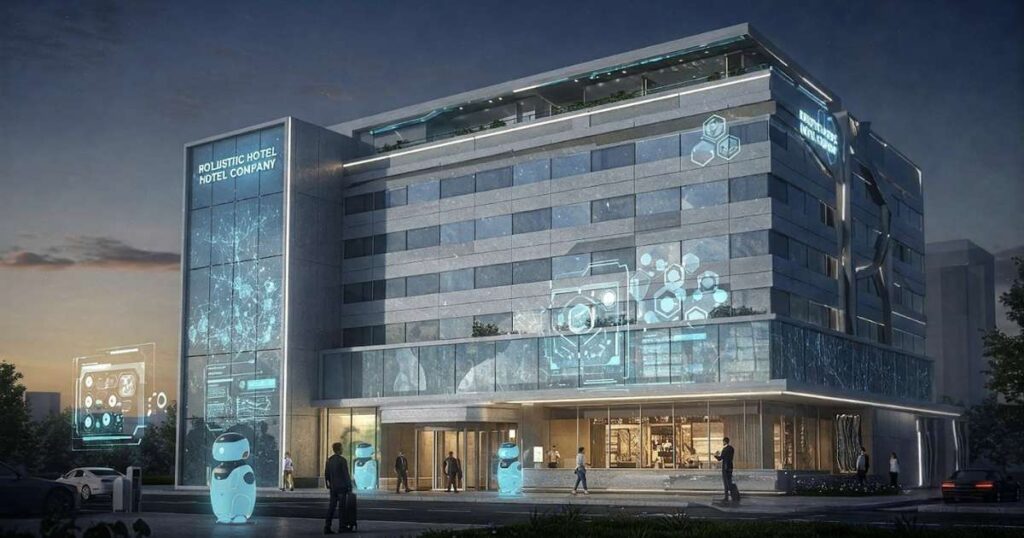Imagine a hotel company that doesn’t rely on a Frankenstein-esque business model cobbled together from a franchise, a management company, and a brand – each with their own agenda, their own KPIs, and absolutely zero alignment. Imagine instead an organization that is sleek, modern, customer-focused, and focuses on hospitality.
The Hotel Company of the Future is exactly what it looks like. It’s not flying in space or serving holographic mojitos yet, but it does something more impressive: it actually works. Efficiently. Cohesively. Profitably. And above all – with the guest in mind.
What are the secrets behind this hospitality masterpiece, then? Glad you asked – let’s dive in.
No Franchises, No Funny Business
This is not a franchising company. Please repeat this: NOT a franchisor. Since I explain this in both books Hospitality 2.0 You can also find out more about the following: Hotel Tech 101The franchise model in the hospitality sector is akin to trying to run a three-chef restaurant where they all hate eachother and refuse to share their recipes. It does not work. This dreaded three legged stool is simply not functional.
Instead, the company is fully owned and operated – or at least operated – by a single, accountable entity. Brand pyramids are not necessary. No licensing drama. One company has full control and responsibility. That means consistency, agility, clarity and one version of reality – without the need to decode ancient scrolls of brand standards or channel a shaman.
Modern, agile and ready to pivot
This is not the hospitality group of your grandmother. The future company is sleek, agile, and anti-“this is the way we’ve always done things.” It’s built to adapt, evolve, and – gasp – invest in things like technology before it becomes outdated.
This company does not fear failure, because it learns and prototypes rapidly, moving on even quicker. Think agile sprints and not waterfall roadmaps lasting five years that never leave the dock. Leadership here isn’t obsessed with corner offices and gold-plated titles – they’re obsessed with growth, change, and guest impact.
Cloud-based Integrated Tech Stack With Middleware Magic
This futuristic engine’s core is a cloud-based, modular technology stack. It consists primarily of third-party best-of breed solutions with some core components created in-house, reflecting and reinforcing the brand’s unique identity. Not just duct-taped APIs but real integration – connected through powerful intelligent middleware that makes even the most stubborn legacy systems show up on time, behave, and say please and thank you.
A central Customer Data Platform (CDP), ensures that all guest touchpoints are not only remembered, but also anticipated. Your guest likes soft lighting, a room at 68°F, and obscure Icelandic jazz? Done. The tech stack does more than just support operations. It powers personalization and drives decisions.
Redesign Operations: No More Silos
Traditional hotel companies have departments that act like estranged relatives – awkwardly smiling in the family photo while secretly blaming each other for everything. What about the hotel of the future? It’s like one organism. Operations, sales, marketing, revenue, finance – everyone is pulling the same cart in the same direction. Instead of reenacting a Russian fable where progress dies a dramatic death in a tug-of-war between a crayfish, a swan, and a nostalgic pike – this crew actually rows like they’ve got a common destination.
Shared KPIs. All incentives are aligned. Everyone has one goal in mind: sustainable profit and customer satisfaction. This isn’t a utopia. This is what happens when people are no longer rewarded for achieving goals that conflict with each other. It’s not rocket science.
Profits are not only RevPAR
Top-line revenue can be a vanity measure. This is like boasting about your large grocery cart, without realizing that it’s filled with broccoli and nobody is eating. Profit is what you should be aiming for. Profit is important not only for investors but also for the survival of the company and its ability to scale.
This company tracks NetTotalRevPAR, cost of acquisition, labor cost per occupied room, ROAS, displacement – you name it. Every decision is made based on the impact it has on the bottom-line, not just how many heads were sleeping in a room Tuesday.
Meet RPOP, the Mechanism Behind it All
At the center of this whole operation is RPOP – the Revenue and Profit Optimization Platform. This isn’t a boosted-up RMS. This is your command center for all of your commercial strategy. It forecasts actual demand by using external and internally generated signals in real-time. It doesn’t just set prices for your hotel rooms – it also guides marketing spends, supports sales strategies, and helps ops decide whether you need ten housekeepers or two and a robot dog.
It’s intelligent, cloud-based, scalable, and shockingly good at diplomacy – it gets all departments talking to each other (in profit language terms).
All Commercial Leaders to Unite Under One Leader
The Chief Commercial Officer (CCO) is the unified leader of your company. Instead of five directors fighting over credit for a group booking, you have one person who can do it all. This person isn’t a referee – they’re a strategist. This person oversees all commercial departments and reports directly to the CEO. They have the budget (and authority) to make real changes.
The CCO isn’t bogged down in spreadsheets – they’re focused on orchestrating commercial symphonies with the help of RPOP, ensuring every department is playing the same song. And most importantly, this person is a data native – someone who comes from the revenue management world, where decision-making is built on numbers, not gut feelings or the shape of the moon. Former revenue leaders are uniquely equipped for this role because they’ve already been trained to think holistically, connect dots across departments, and measure success in terms that actually show up on a P&L. If anyone understands the power of unified data, demand forecasting, and profit optimization – it’s them.
Automated Lean Scalable Operation
Thanks to automation, this company runs lean – like, actually lean, not “we cut everyone and now ops is on fire” lean. Tech handles routine tasks. Forecasting, rate updates, reporting – all done by machines.
This allows staff to concentrate on things that technology cannot do, such as thinking strategically, building relationships and making guests feel like Rockstars. Labor costs go down, service quality goes up. Everyone wins. Even the robot dog.
The guest is still the star
The twist is that despite the AI, cloud platforms and algorithmic wizardry this is still an hospitality-first company. Not technology first. Finance is not first. Hospitality-first. Guest satisfaction is an important metric. Not only does it look good on the annual report; it also drives loyalty and reputation.
Guest satisfaction fuels loyalty, word-of-mouth marketing, five-star reviews, and repeat business – the holy grail of sustainable profitability. It’s more than just avoiding complaints. It’s creating “wow moments” that guests remember and post about. It doesn’t matter if it’s a room that automatically adjusts its lighting to the guest’s preference, or a local snack on hand with a note written by the host.
This hotel company isn’t interested in cookie-cutter service – it’s about delivering a consistent brand experience with room for personalization. Guests are made to feel special, valued, and even surprised at times (in a thoughtful way, like “how did they find out I loved chamomile?” Guests feel welcomed, appreciated and sometimes surprised (in a thoughtful way: “How did they know that I loved chamomile?” way).
Yes, technology is the engine. Profit is what makes the world go around. But what about hospitality, then? But hospitality?
Local Flavor, Brand Consistency
Last but not least, there is the brand. It is clear, consistent and memorable. The guests know what they can expect: comfort, ease of use, and a brand which delivers.
They walk into any of your branded properties and know the vibe, the standards, and the service level they can count on – yet they still get that unique local flavor that makes it feel fresh, exciting, and rooted in place.
It’s not cookie cutter. It’s cupcake-with-regional-frosting. It’s familiar yet exciting. Like a great sequel without ruining the original.
The Final Unboxing
This hotel company doesn’t exist in a vacuum. It is a blueprint for what we can achieve when we stop accepting the “traditional” way of doing things and start building on what actually works. It is lean, intelligent and coordinated. It’s scalable. And it’s guest-centric.
The only question now is, who will be bold enough to build this?


